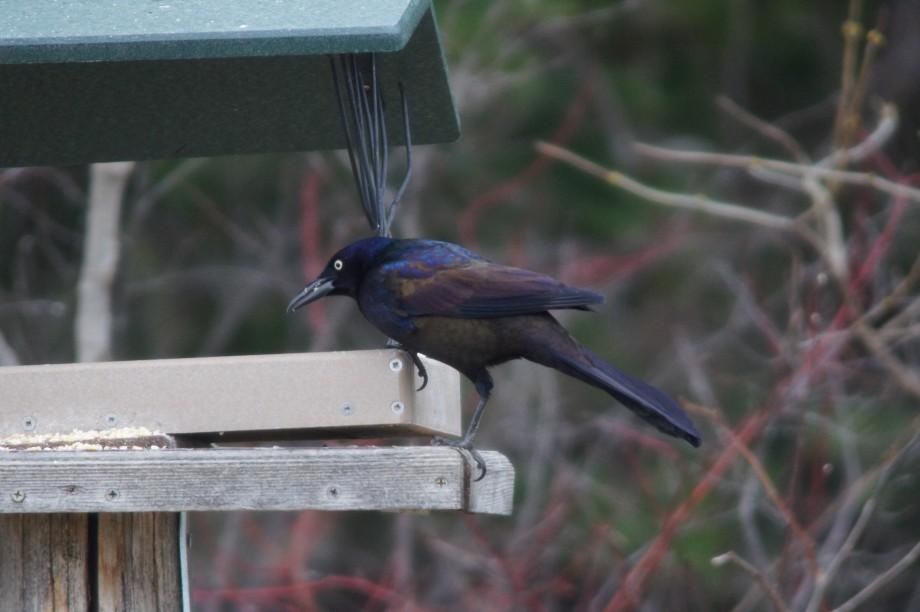Arriving spring birds are one of the highlights of the birdwatching calendar. In fact, birders generally measure the progress of spring not in day length or temperatures, but in the birds they are beginning to see. As snow melts and frozen waterways become ice free, birdwatchers excitedly search the softening landscape for these birds winging their way in from the south. And while the songs of year-round resident species such as black-capped chickadees and brown creepers add to the fervor of spring, it is often the new arrivals that get birders most excited.

The main thrust of Adirondack breeders is still to come from the south. Most of these species are neotropical migrants – birds that winter in Latin America or the Caribbean, but breed here in North America. They will arrive largely in May when the weather warms more permanently, leaves come out, and perhaps most importantly, there are many bugs to eat.
But short distance migrants – birds that spent the winter in the southeast or the Mid-Atlantic States – have started arriving the past few weeks. Some of these birds have arrived earlier than usual – likely because the mild winter didn't force them far south and the unseasonably warm spring allowed them to return early. These harbingers of spring not only add their own voice to backyards and woodlands after a quiet winter, but they bring with them the promise of ever-increasing Adirondack avian diversity over the next few months.
Birds making their first appearance of the season are spread over a wide area – after all the Adirondacks encompass an enormous region. And so reports have come in of new spring birds from across the North Country. Here are a few from our area.
Waterfowl are among the earliest migrants as they migrate to northern ponds and lakes. While everyone is familiar with the arrival of Canada geese (and that has been occurring over the past few weeks), snow geese fly over in the hundreds and thousands. Many of the largest flocks are along the Champlain Valley (a good corridor for migrating waterfowl), and I have seen large flocks over Lake Placid in the past few days. Lone snow geese also put in cameos on both Lake Flower in Saranac Lake and the pond at The Wild Center in Tupper Lake.
Many other species of waterfowl which breed in the Adirondacks or pass through the region have also been showing up since the ice began to break up on Adirondack lakes. In more usual springs the lakes that melt first are the best places to look, but this year with its fast rising temps and consequential open water has allowed access for ducks to lakes and ponds across the region.
Besides mallards with which everyone is familiar (and some mallards remained all winter), several other species of ducks are

Not to be outdone, upland birds have been likewise making their first appearance. Many people notice the arrival of American robins (which are now back in good numbers), but song sparrows started arriving in my yard in late February, and now our neighborhood is full of them. Red-winged blackbirds are gurgling their "kon-ka-reee" from area marshes and numbers of common grackles and winter wrens are steadily increasing. A friend of mine also found two rusty blackbirds in Bloomingdale Bog north of Saranac Lake last week, and there was an eastern phoebe calling at The Wild Center on March 20th.
Saw-whet owls – some of which overwintered in this mild winter – are also starting to call. Saw-whets are small (about 8 inches long) owls that use toots in the middle of the night in early spring to attract mates. I also heard a red-shouldered hawk calling along the Fish Pond Trail in Lake Clear, while I was skiing on St. Paddy's Day, and I saw a turkey vulture soaring over Saranac Lake on March 26th.
Finally, American woodcocks – rotund relatives of sandpipers and other shorebirds - have also begun calling and displaying for mates. I had one calling from a neighbor's yard on March 13th – about a month earlier than we heard one last year, and a friend of mine who lives in Raybrook has had several calling near her home. Their mating display is one of the most fun things to witness as spring progresses.
According to the calendar spring is officially here. But calendars and longer days aren't the only ways to know for certain. Just pay attention to the birds. More are arriving each day.




